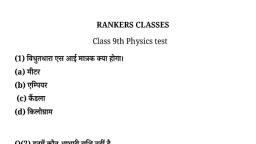Question 3 :
A mixture of methyl alcohol and acetone can be separated by
Question 4 :
The most suitable method of the separation of a 1 : 1 mixture of orthoand para nitrophenols is
Question 8 :
The volume of a colloidal particle, $V_c$ as compared to volume of solute particle $V_s$ in a true solution could be:
Question 9 :
The percentage by mole of ${ NO }_{ 2 }$ in a mixture of ${ NO }_{ 2 }(g)$ and $NO(g)$ having average molecular mass 34 is :<br/>
Question 10 :
The formula of a compound between a group $13$ element, $M$, and a group $15$ element, $X$, will be:
Question 11 :
Which of the following statements best explains the law of conservation of mass?
Question 12 :
When gases C and D were passed through a hot tube of powdered copper, gas C reacted to form CuO. The remaining gas, D, was collected in a third $821$ ml flask and found to have the mass of $1.68$g and pressure of $1.8$ atm at $27^o$C. How many moles each of C and D were present and what are their likely identities?
Question 13 :
Amongst the following statements, that which was not proposed by Dalton was :
Question 15 :
Liquids can be poured easily whereas solids cannot be pour because of:
Question 16 :
An earthenware keeps water cool but metallic vessel does not because __________.
Question 18 :
Assertion: Water kept in an earthen pot becomes cooler during summers.
Reason: Evaporates taking latent heat and removal of latent heat results on cooling. Earthen pots have small pores through which the water seeps and as evaporation leads to cooling of the substance.
Question 20 :
What is the pressure of gas in the cylinder after $1$ h?
Question 21 :
An amount of $1$ mole of a gas is changed from its initial state($20$L, $2$ atm) to final state($4$L, $10$ atm), respectively. If the change can be represented by a straight line in P-V curve, the maximum temperature achieved by the gas in the process is?($R=0.08$L-atm/K-mol)
Question 22 :
Under what pressure will carbon dioxide have the density of $2.2$ g/litre at $300$K? For $CO_2$, $a=3.6$ atm $l^2 mol^{-2}$ and $b=0.05$ $l-mol^{-1}$.
Question 23 :
The pressure exerted on walls of a $3$L flask when $7$g of $N_2$ is introduced into it at $300$K should be?(assume ideal behaviour of gas)
Question 24 :
Isotopes of cobalt .......... is used in the treatment of cancer.
Question 25 :
Which of the following combinations of particles represents an ion of net charge $-1$ and of mass number $80$?
Question 26 :
Assertion: In Rutherford's gold leaf experiment, most of the $\alpha$ particles passed through the foil
Reason: The entire positive charge and nearly all of the mass of an atom is concentrated in the nucleus
Question 27 :
The mass of $_{3}^{7}{Li}$ is $0.042$ less than the mass of $3$ protons and $4$ neutrons. The binding energy per nucleon in $_{3}^{7}{Li}$ is:
Question 28 :
Fill in the blank and complete the analogy by choosing the correct alternative from the options given.Helium : Duplet state : : Argon : _________
Question 29 :
The atomic number$(z)$ of an element is 24. In its ground state how many electrons are present in the $'N'$ shell?
Question 30 :
When a gold sheet is bombarded by a beam of $\alpha$-particles, only a few of them get deflected whereas most go straight, undeflected because:<br/>
Question 31 :
The formation of the oxide ion, O$^{2-}_{(g)}$, from oxygen atom requires first an exothermic and then an endothermic step as shown below:<br/>$O_{(g)} + e^{-} \rightarrow O^{-}_{(g)}; \Delta H^{\circ} = -141 kJ mol^{-1}$<br/>$O_{(g)}^{-} + e^{-} \rightarrow O^{2-}_{(g)}; \Delta H^{\circ} = +780 kJ mol^{-1}$<br/>Thus, process of formation of $O^{2-}$ in gas phase is unfavourable even though $O^{2-}$ is isoelectronic with neon. It is due to the fact that:
Question 32 :
Statement 1: The value of Avogadro's constant is $6.022\times {10}^{23}$<br/>Statement 2: Mole is the ratio of number of atoms present in the substance to the Avogadro number.<br/>Now choose the correct option :
Question 33 :
Which of the following postulates does not belong to Bohr's model of the atom?





























































